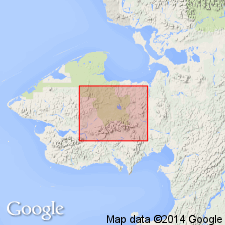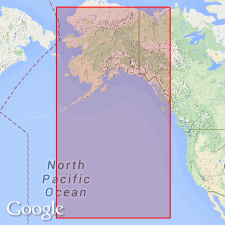
- Usage in publication:
-
- Kanauguk Formation
- Modifications:
-
- Named
- Dominant lithology:
-
- Limestone
- Schist
- AAPG geologic province:
-
- Alaska West-Central region
Summary:
Sainsbury (1969) first described rocks as of pre-Ordovician age where well exposed in York Mountains in Teller quad, Seward Peninsula, AK. Mapped in Bendeleben quad, Seward Peninsula, AK. Consists of thick unit of thin-bedded argillaceous and dolomitic limestone but intensely schistose on east side of Darby Mountains. Contains thin veinlets of vitreous quartz. Weathers to distinct orange color. Thickness undetermined. Conformably overlies York Slate (new). Underlies folded thrust sheet of Paleozoic limestone converted to dolomite along east side of Darby Mountains. Late Precambrian age is based on stratigraphic relations with York Slate.
Source: GNU records (USGS DDS-6; Menlo GNULEX).

- Usage in publication:
-
- Kanauguk Formation*
- Modifications:
-
- Age modified
- AAPG geologic province:
-
- Alaska West-Central region
Summary:
Kanauguk Formation of Sainsbury (1974) is definitely pre-Ordovician and may be Precambrian or Cambrian age.
Source: GNU records (USGS DDS-6; Menlo GNULEX).
For more information, please contact Nancy Stamm, Geologic Names Committee Secretary.
Asterisk (*) indicates published by U.S. Geological Survey authors.
"No current usage" (†) implies that a name has been abandoned or has fallen into disuse. Former usage and, if known, replacement name given in parentheses ( ).
Slash (/) indicates name conflicts with nomenclatural guidelines (CSN, 1933; ACSN, 1961, 1970; NACSN, 1983, 2005, 2021). May be explained within brackets ([ ]).

